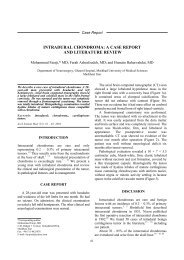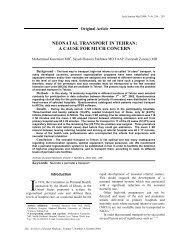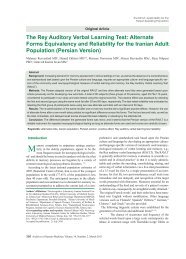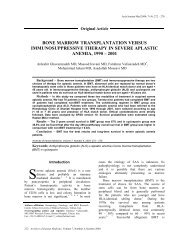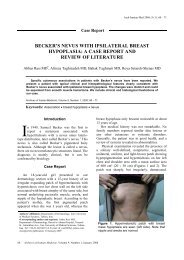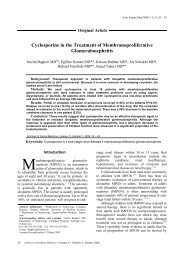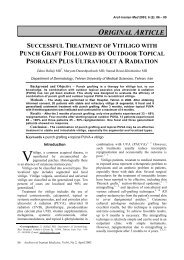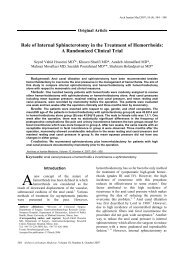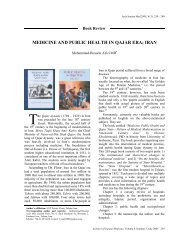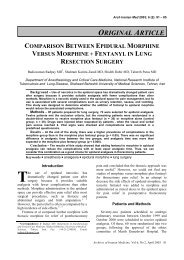Excerpts from Persian Medical Literature
Excerpts from Persian Medical Literature
Excerpts from Persian Medical Literature
You also want an ePaper? Increase the reach of your titles
YUMPU automatically turns print PDFs into web optimized ePapers that Google loves.
Arch Iranian Med 2004; 7 (2): 165 – 166<strong>Excerpts</strong> <strong>from</strong> <strong>Persian</strong> <strong>Medical</strong><strong>Literature</strong>MACRONUTRIENT INTAKE IN RELATION TO BODY MASS INDEX: TEHRAN LIPIDAND GLUCOSE STUDY (TLGS)Human studies investigating the relationship between obesity and diet composition have failed to achieveconsistent findings. This study was undertaken to assess the relationship between macronutrient intake andbody mass index (BMI) in a group <strong>from</strong> Tehran, Iran. A total number of 1,290 subjects over 10 years of age(565 males and 725 females) were selected randomly for dietary survey <strong>from</strong> the participants of TehranLipid and Glucose Study (TLGS). Anthropometric indices were measured according to standard protocolsand BMI was calculated. Dietary data were collected by trained interviewers using two nonconsecutive, 24-hour dietary recalls. Under- and over-reporting of energy intake were defined as energy intake to BMI < 1.35and ≥ 2.4, respectively. Calorie-adjusted amounts of macronutrients were calculated by the residual method,following which energy intakes <strong>from</strong> all calorie-adjusted macronutrients, were simultaneously included inthe multiple regression model controlling for confounding variables and mutual effects of macronutrients.Total energy intake was not included to avoid co-linearity. After excluding under- and over-reporters, BMIdid not change in males but decreased in females. Misreporting of energy intake increased with age andBMI. Excluding misreporters caused significant changes in actual amounts of macronutrient intakes ofwomen, but not of men. In all cases, adjusting for energy caused a significant increment in the amounts ofprotein. Controlling for confounding variables, energy intake <strong>from</strong> fat was positively associated with BMI inmales and females (β = 0.61, p < 0.01 and β = 0.75, p < 0.01, respectively). This relationship remained afterexcluding misreporters (β = 0.66, p < 0.01 and β = 0.78, p < 0.01, respectively). No association was seenbetween energy intake <strong>from</strong> protein and carbohydrate with BMI in subjects before and after excludingmisreporters. We have found evidence indicating that energy <strong>from</strong> fat is positively associated with obesity.No other association was observed between energy <strong>from</strong> protein and carbohydrates with BMI.Authors: Mirmiran P, Esmailzadeh A, Azadbakht L, Mohammadi F, Azizi F.Source: Iranian Journal of Endocrinology and Metabolism. 2003; 5: 195 – 202.A SURVEY ON GASTROINTESTINAL AND HEPATIC MANIFESTATIONS OFBRUCELLOSISBrucellosis is a zoonotic disease of worldwide distribution. Despite its control in many developingcountries the disease remains endemic in Iran. The symptoms, signs, and laboratory results are variable andnonspecific. This study was conducted to determine the hepatic complications of brucellosis in Iran. Westudied 188 patients (108 males and 80 females) with brucellosis. They were 1 – 79 years old (mean 34.8years) and were registered during 1995 – 2001 in Imam Khomeini Hospital, a referral center in Tehran.Thirty-four of 188 cases (18.08%) had elevated liver enzymes [elevated serum glutamic-oxaloacetictransaminase (SGOT) in only 6 patients; elevated serum glutamic-pyruvic transaminase (SGPT) in onepatient; and elevation of both transaminases, in 27 patients]. The prominent symptoms included anorexia (74cases), weight loss (62 cases), right upper quadrant pain (32 cases), epigastric pain (25 cases), and nauseaand vomiting (23 cases). Hepatomegaly was seen in 28 patients and jaundice and ascites were present in only7 and 3 patients, respectively. Other laboratory results showed elevated alkaline phosphatase in 28 cases andabnormal bilirubin in 10 cases. Fifty-seven patients had a focal illness, representing 30.32% of all thepatients. Osteoarticular complications were the most frequent focal forms, being present in 34 cases. Twelvemale patients had genitourinary brucellosis representing 10.53% of focal forms. Also, 5 patients hadneurologic complications. In conclusion, hepatic involvement is frequent in brucellosis, although the rate ofArchives of Iranian Medicine, Volume 7, Number 2, April 2004 ١۶۵
<strong>Excerpts</strong> <strong>from</strong> <strong>Persian</strong> medical literaturethis complication in our study was lower than other studies. So, in patents with overt clinical or laboratoryfindings compatible with liver disturbance etiologies other than brucellosis should be considered in Iran.Authors: Ahmadi-Nejad Z, Rasouli-Nejad M, Mahmoudi M, Rezaei N.Source: The Journal of Faculty of Medicine. 2003; 61: 144 – 52.INCIDENCE OF REINFECTION WITH HELICOBACTER PYLORY ONE YEAR AFTERSUCCESSFUL TREATMENTHelicobacter pylory (HP) is an essential factor in gastritis, gastric ulcer (GU), duodenal ulcer (DU),gastric cancer, and lymphoma. Eradication of HP causes prevention of peptic ulcer and its complications. Indeveloped countries, reinfection with HP is rare, but in developing countries reinfection is possible andvaries in different countries. The aim of this study was to discover the infection with HP in Iranian patientsone year after treatment. Study was done in 110 patients, 57 men and 53 women, with DU (85.4%), GU(20%), and severe gastritis (12.6%). Diagnosis of HP infection was based on rapid urease test, histology, orculture. These patients were treated with different drugs. Eradication was documented with C 14 urea breathtest (C 14 UBT), four weeks after termination of the treatment. One year after the first negative C14UBT,averaging 17 months (12 – 29 months), these patients were surveyed, on the bases of clinical symptoms andC14UBT. From 110 patients, after one year, 21 patients had positive C 14 UBT (19%). Age, sex, familynumber, GI problems, and smoking were not suggestive of reinfection. In this study reinfection with HP washigh, specially in complicated DU and GU, and maintenance therapy with H 2 blockers.Author: Talebi M.Source: Journal of Isfahan <strong>Medical</strong> School. 2003; 21: 21 – 3.INCIDENCE OF CARDIOVASCULAR RISK FACTORS IN HYPERTRIGLYCEMIC-WAIST MALES (TEHRAN LIPID AND GLUCOSE STUDY)Many studies performed on nontraditional risk factors have proposed a metabolic triad includingincreased serum level of apolipoprotein B, hyperinsulinemia, and high low density lipoprotein-cholesterol asa risk factor of cardiovascular disease. Hypertriglycemic waist (increased waist circumference as well ashigh fasting triglycerides) can be used as a simple criterion to predict metabolic triad. The aim of this studywas to investigate the prevalence of hypertriglycemic waist and the frequency of cardiovascular risk factorsin the affected population. The study was performed on 18 – 70 years old males of the population of TehranLipid and Glucose Study (TLGS). The subjects fell into four groups with respect to serum level of fastingtriglycerides (Tg) and waist circumference (W). Subjects of TgHWH group had serum Tg > 160 mg/dL aswell as W > 95 cm while those of TgHWL group had Tg > 160 mg/dL and W < 95 cm. Triglycerides levelwas less than 160 mg/dL in TgLWH and TgLWL groups whereas waist circumference was higher than 95cm in TgLWH and lower than 95 cm in TgLWL. Cardiovascular risk factors, anthropometric, and laboratoryvariables were compared between groups. A total of 4,169 subjects were enrolled of whom 784 had highserum levels of triglycerides as well as increased waist circumference. The prevalence of cardiovascular riskfactors was significantly highest in TgHWH group. The mean age of subjects was significantly higher inTgHWH compared to others (37 ± 15, 48 ± 14, 41 ± 13, and 46 ± 13 years in TgLWL, TgLWH, TgHWL,and TgHWH, respectively, p < 0.001). Systolic and diastolic blood pressures and body mass index weresignificantly higher in TgHWH than others. Serum total cholesterol, triglycerides, and LDL-C weresignificantly higher in TgHWH compared to others, whereas HDL-C was significantly lower in this group.The prevalence of subjects who had at least four risk factors was 75% and 10% in TgHWH and TgLWH,respectively. Hypertriglycemic waist can be used as a simple criterion to predict cardiovascular risk factor.Authors: Ghanbili MJ, Mirmiran P, Solati M, Majeed M, Azizi F.Source: Iranian Journal of Endocrinology and Metabolism. 2003; 5: 179 – 85.١۶۶Archives of Iranian Medicine, Volume 7, Number 2, April 2004



